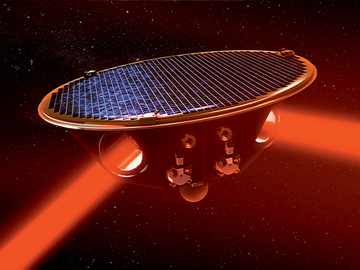![]()
The ultra-stable optical bench designed by the Max Planck team was used to calibrate the phasemeter for the LISA mission—to picometer-scale precision—via the interference of three laser beams. [Image: D. Penkert/Max Planck Institute for Gravitational Physics]
The LISA mission—an ambitious undertaking, slated for launch in 2034, to measure gravitational waves via a giant, space-based laser interferometer—will need to detect changes of a few picometers, or trillionths of a meter, in the distance between spacecraft millions of kilometers apart. How can one even begin to measure and confirm those kinds of tolerances on planet Earth, to vet the new technology being built for the mission?
Scientists at the Max Planck Institute for Gravitational Physics, Germany, have now built an ultra-stable optical bench that they say could serve as a ground-based testbed to solve part of that verification puzzle (Phys. Rev. Lett., doi: 10.1103/PhysRevLett.122.081104). In three-laser interferometric tests of phase noise, the testbed showed stability at “LISA-like picometer levels,” and the ability to verify equipment at precisions an order of magnitude better than comparable state-of-the-art testbeds. The setup, the team concludes, shows that key parts of the space-based system can be tested in the laboratory on Earth.
2.5-million-km interferometer arms
Like the ground-based detectors LIGO and Virgo, LISA—which stands for Laser Interferometer Space Antenna—will detect gravitational waves by sensing infinitesimal changes in the length of multiple fixed laser beams, as gravitational waves go rumbling by and disturb the fabric of spacetime (see “Gravitational Waves: The Road Ahead,” OPN, May 2018). The mission, led by the European Space Agency (ESA), will consist of three spacecraft, arranged as vertices of an equilateral triangle, with each side of the triangle measuring 2.5 million kilometers. The three spacecraft will sit at the L1 Lagrange point, a gravitationally neutral point between Earth and the sun, around a million kilometers from Earth.

Artist’s view of one of the satellites of LISA. [Image: AEI/Milde Marketing/Exozet]
In the LISA setup, ultra-stable, 1064-nm lasers will shine between the vertices of this massive space triangle and bounce off of free-falling, gold-coated test masses in the spacecraft. Changes in the travel-time measurements between the test masses in the different spacecraft, detected by heterodyne interferometry in digital “virtual” Michelson interferometers on the ground, will signal the presence of a gravitational wave.
A previous space-based trial effort, the 2015-2017 LISA Pathfinder mission, has already impressively demonstrated the ability to put free-falling test masses into orbit and measure their relative motion. That success set up the next phase of hardware and technology development for LISA itself.
Picometer-scale sensitivity
Because of its enormous reach, LISA should be able to detect gravitational waves at frequencies between 100 μHz and 1 Hz, a frequency band that’s inaccessible to Earth-based detectors and that could open a window to high-energy events in the “cosmic dark age,” less than 150 million years after the Big Bang. To make those measurements, however, LISA will need to be able to pick up length changes (more precisely, phase changes in the interferometric signal) on the order of picometers in scale. That, in turn, will require a phasemeter that can cancel out laser frequency noise, Doppler shifts and other noise sources to extract the delicate displacement signal in the measured phase change.
Such a phasemeter is being developed under ESA contract—but how to test it? The Max Planck team, led by Gerhard Heinze, began their effort to answer that question by building an elegant, remarkably stable platform to on which to sit the test. The platform is an optical bench consisting of a thick baseplate made of the Schott glass-ceramic material Zerodur, on which are mounted three fiber injectors to provide the light from three Coherent 1064-nm lasers.
Six wedged beam splitters, arranged in a hexagonal pattern, allow the beams to be configured into three separate interferometer setups; the interferometer signals, in turn, are combined, with digital control loops set up to allow heterodyne beat notes at the 5-to-25-Hz frequency envisioned for LISA. The output beat notes are captured via photoreceivers, consisting of InGaAs photodiodes and amplifiers, that send the beat signal to the phasemeter for interpretation. The whole setup sits in a vacuum chamber at pressures kept below 10 mbar.
Testing the phasemeter
The team tied this setup to the phasemeter being developed for the ESA mission. The researchers found that their optical bench “provides sufficient stability down to LISA-like picometer levels,” and were able to use that precision to conduct benchmark tests of the phasemeter “with LISA-like dynamic range and heterodyne frequencies.” The team believes it can reduce the testbed’s noise, and hence its measurement precision, even further with improved photodetectors.
Even as it stands now, the researchers maintain that their testbed can measure at precisions an order of magnitude better than other, comparable systems, and they believe that it can be extended to measure other key components of LISA metrology. “It’s crucial to understand all the details of the LISA mission precisely and to test them in advance in the laboratory,” team leader Heinzel noted in a press release accompanying the work. “Only in this way can we be sure that the complex mission will work as planned. Once the satellites are in orbit around the sun, we can no longer modify the hardware.”
